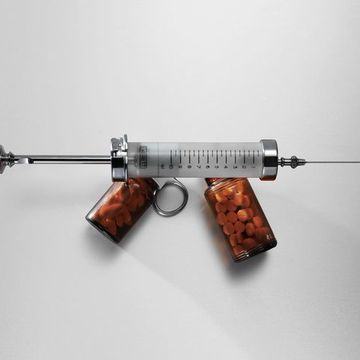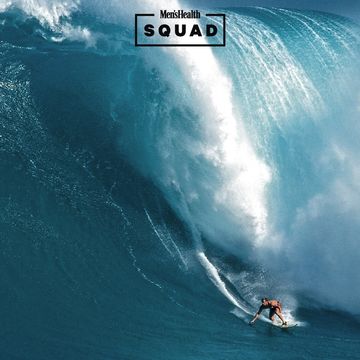Massively muscular and popular on its 1981 release, the original He-Man action figure was conceived to make other boys' toys look “wimpy”. Roger Sweet, then a designer at toy giant Mattel, astutely thought “an unbelievably ripped hombre like that would be compelling for boys, since every boy - or man, for that matter - would love to have the kind of anacondas hanging from his shoulders that make people draw back in awe”. (As he wrote in his 2005 book Mastering the Universe: He-Man and the Rise and Fall of a Billion-Dollar Idea.)
Sweet himself had been so small in high school that the football coach cut him from the team without even watching him play. In college he could do 140 press-ups, and was influenced by Charles Atlas ads to become “more physically powerful”, but he never transformed his body as they promised. “I always wanted to be a He-Man but never could,” he recently told his local paper aged 84 and, in his own words, “a scrawny old guy”, albeit one able to do 23 pull-ups two decades after recovering from cancer.
Fatally diluted with new characters who saturated retailers’ bargain bins, He-Man was cancelled in 1987 along with the rest of his hitherto massively profitable Masters of the Universe line. But clearly he still has some power, because not one but two new versions of He-Man are hitting Netflix this year.
Masters of the Universe: Revelation, an anime-style homage directed by Kevin Smith with Mark Hamill voicing Skeletor (one for the grown-ups), is slated for 21 July. In the Bonnie Tyler-soundtracked teaser trailer He-Man looks to be in pretty good shape, literally and metaphorically, after 40 years. Whether he’ll be figuratively as big as before remains to be seen. But in the promo shot for He-Man and the Masters of the Universe, a stylised CGI "reimagining" (one for the kids), release date TBC, he looks physically bigger.
Answering Mattel’s call for a “generic” action figure, Sweet used clay to bulk up a Big Jim - an existing toy with, despite the name, a relatively slim build. The resulting figure, if scaled up to 6’1”, would’ve weighed 720lb; Arnold Schwarzenegger, the reigning Mr Olympia, was a mere 230lb. Sweet chose the generic but nevertheless evocative name “He-Man”, meaning muscular, strong and, depending which dictionary you read, virile.
Mark Taylor, then an artist at Mattel, also claims to have created He-Man, and certainly the character’s finished look resembles his drawings much more closely than Sweet’s primitive prototype. Sweet disputes that, and says he rejected Taylor’s initial template because the physique was too “average”. While the truth is lost in the mists of Eternia, there’s no disputing the earth-shattering extraordinariness of He-Man’s rig, which introduced boys to obliques and the serratus anterior before “six-pack” officially entered the cultural lexicon.
“When He-Man hit, no action figures looked like that,” says David Vonner, a toy designer who has worked at Mattel, Hasbro and ToyBiz, and was a talking head on the He-Man episode of Netflix documentary series The Toys That Made Us. Wanting to become a comic book artist, he gravitated to the line for its anatomical detail, using the figures as life models. Prior to He-Man, he says, “everyone just had the proportions of a normal human being”. Then along came Arnie: “a fantastic specimen of genetic, just, wellbeing”. (And anabolic steroids, of course, but more on those anon.)
Having passed on 1977’s Star Wars, a misjudgement of not-signing-the-Beatles proportions, Mattel explored creating a toy line for 1982’s Conan the Barbarian until it realised the Arnie film would be too violent for children. Besides, licensing films that sometimes left cinemas before the toys even arrived on shelves rarely paid off (apart from Star Wars). So Mattel decided to create its own character, universe.
Sweet said he was inspired by the “physically powerful” art of Frank Frazetta, who drew Conan among other characters and incorporated science fiction as well as fantasy - as did He-Man. Mattel’s market research had thrown up the themes of barbarian monster and space military along with the idea of “power”. Fed up with taking orders from parents and teachers, boys wanted it; He-Man had it. The line’s original name was “Lords of Power”.
Lacking a film to tell the story, Mattel fleshed out a mythos with mini-comics and, most innovatively, the 1983 animated series He-Man and the Masters of the Universe, which capitalised on newly relaxed US regulations about marketing to children on TV. Toys could now become cartoons and films, with 1987’s Masters of the Universe starring Dolph Lundgren - “far slenderer” than the action figure, according to the unimpressed Sweet, who alleged the action star had definition painted on. (Lundgren disputes this.)
Animation studio Filmation and Mattel didn’t have completely free reign. To assuage concerns that the series might be too violent or scary, every episode had a moral bolted on. Skeletor was played for high-pitched laughs and He-Man was almost comically pacifist considering he was strong enough to save his friends from being drowned by a rising tide by pushing away Eternia’s moon. A Washington Post op-ed accused him of being “a plot to turn children into bleeding hearts”.
The series also gave He-Man a campy alter-ego in Prince Adam, who introduced another powerful idea: transformation. Barely disguised by his skintight pink-and-purple get-up, Prince Adam’s suspiciously muscular physique wasn’t as much of a giveaway as it might’ve been because, to save money, Mattel had used the same torso for all the male action figures. So with the exception of floating wizard-thing Orko, another TV addition, every guy in the Masters universe was as muscular as He-Man. (The trailer for Masters of the Universe: Revelation gives Prince Adam a more discernible before-and-after.)
The muscularity of action figures has “definitely increased” over time, says Dr Roberto Olivardia, a clinical psychologist and lecturer in psychology at Harvard Medical School. That partly reflects developments in other incarnations of long-running characters: in comic books, on the big screen (compare Adam West as Batman to Christian Bale, or Christopher Reeve as Superman to Henry Cavill) and in computer games.
But action figures have developed out of all human proportion. Dr Olivardia co-authored a 1999 study that found the original 1964 GI Joe had the equivalent of a none-too-shabby 44-inch chest and 12-inch bicep, whereas the mid-Nineties GI Joe “Extreme” boasted the equivalent of a 55-inch chest and 27-inch bicep - almost as big as its waist, and bigger than the guns of contemporary competing bodybuilders. Another study compared action figures of Batman, Superman, Spider-Man and the Hulk as well as GI Joe and showed that, over 25 years, some of their body parts had enlarged by 70 per cent. And that was in 2005.
The advent of steroids in the Sixties and Seventies enabled greater muscularity than was possible naturally, wrote the co-authors, such that bodybuilders from the pre-steroid era “could not hope to compete”. This historically unprecedented swelling may have contributed to the prevalence of male body dissatisfaction, eating disorders and muscle dysmorphia, also called “reverse anorexia” or “bigorexia”, whereby sufferers obsess they’re too small no matter how massive they might be.
GI Joe’s arms race, wrote the researchers, appeared to represent a “male analog” of studies on female toys such as Barbie, also made by Mattel, who’d gotten thinner over time to the point where she had the equivalent of a 16-inch waist. While it’d be “premature” to conclude that body image concerns grew solely from boyhood exposure to muscular ideals, “the impact of toys should not be underestimated”.
Fitness model and actor Daniel Ventura played He-Man in the recent series of ads for a certain price comparison website - a dream come true as the character and his other hero growing up, Arnie, sparked his interest in weightlifting. The ad makers originally intended to showcase Ventura's real physique, but he looked like the “little brother” of the blue muscle suit-clad dancer playing Skeletor, so they also put him in prosthetics: “I thought, ‘Well, that was a waste of time training for the last three decades.’”
Even sitting or lying down felt like training in the suit, which weighed a ton and was “very uncomfortable”. It did bestow a sense of presence on Ventura, who felt “like an articulated lorry”, and increased his 44-inch chest to, he guesses, around 77 inches. He can’t say he liked being that big, nor would he ever aspire to be in real life - but then getting so with training and diet would be “impossible”. Nevertheless, some people, on seeing the advert, commented that he must’ve trained hard, to his amazement. He’d assumed it was obvious from the size and definition that he was wearing a muscle suit.
Boys are “attracted to the idea of power”, says Dr Olivardia, backing up Mattel’s market research. Muscularity and strength aren’t the only forms of power, of course, but biologically boys are “going to be programmed to idolise those things”, which evolutionarily may have been associated with protection and food. (Although “survival of the swolest” is bro anthropology: homo sapiens prospered by cooperating, not competing.)
Cultural differences in the drive for muscularity around the world however indicate that it’s nurture and not nature that primarily defines the physical ideal - which, in many Western societies, is now bigger and leaner than nature intended. “And that line just keeps going up and up in ways that could be really unhealthy,” says Dr Olivardia. Bruce Lee wasn’t the biggest but was still badass, and a He-Man half the size could, thinks Dr Olivardia, still appeal just as much. Although maybe he didn’t see the poorly received 1990 series The New Adventures of He-Man, with its svelter, ponytailed protagonist.
Mattel has always disputed claims that Barbie negatively impacts girls’ body image but in 2016 introduced three new shapes: petite, tall and curvy. The company didn’t respond to a request from Men’s Health for comment about whether He-Man might be promoting unrealistic body image for boys, or whether the Masters universe could expand to include more diverse shapes.
But then there isn’t much conversation at all around boy’s body image - or men’s, for that matter - because, says Dr Olivardia, of lack of research, the stereotype of males as tough and the perception that obsessively pursuing muscularity isn’t as much of a problem as starving yourself thin, even though it can also ruin lives and prematurely end them.
That’s not to say He-Man should be cancelled (again), and clearly he’s stylised in the new CGI version. But his bicep is bigger than his head: what kind of message does that give boys about what kind of men they should grow up to be? And research shows that knowing an image isn’t real doesn’t prevent observers comparing themselves negatively. (Hence why social media filters and other photo editing tools are so pernicious.)
It’s “a natural, innate, human thing” for boys to idolise "a big, strong, muscular guy", says Vonner. And being fit “should be universal”. The important thing is communication: getting across that the benefits aren’t about aesthetics. A naturally lean guy who’s never been able to put on weight, he started doing pull-ups in the park not to build muscle but to ward off depression after a series of job losses and relocations across the US.
We live in a different time but we can celebrate things of the past when people didn’t consider the consequences, says Vonner - just be more mindful of how we present it to the future. And if we have a healthier, more active lifestyle - “not necessarily to look like Adonises” - then, he thinks, we’ll have a better life. We will understand the value of living better, maybe even treat each other better. That's a moral of which He-Man would be proud.


















